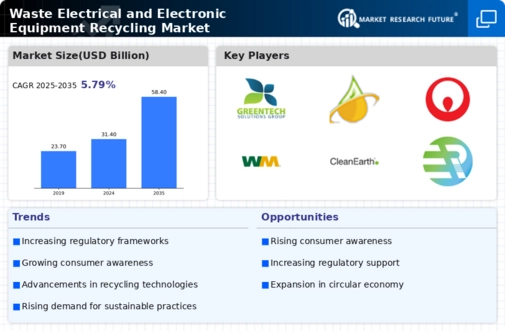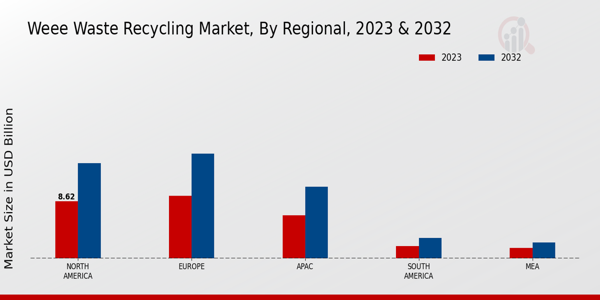Market Growth Projections
The Global Waste Electrical and Electronic Equipment Recycling Market Industry is poised for substantial growth, with projections indicating a rise from 31.4 USD Billion in 2024 to 58.4 USD Billion by 2035. This growth trajectory reflects a compound annual growth rate of 5.79% from 2025 to 2035, driven by various factors including increased e-waste generation, regulatory pressures, and advancements in recycling technologies. The market dynamics suggest a robust demand for recycling services, as stakeholders recognize the economic and environmental benefits of effective e-waste management. This upward trend underscores the critical need for sustainable practices in the electronics lifecycle.
Increasing E-Waste Generation
The rapid advancement of technology and the proliferation of electronic devices contribute to a substantial increase in e-waste generation globally. In 2024, the Global Waste Electrical and Electronic Equipment Recycling Market Industry is projected to reach 31.4 USD Billion, driven by the growing consumer demand for the latest gadgets. As devices become obsolete at an accelerated pace, the volume of discarded electronics rises, necessitating effective recycling solutions. This trend underscores the importance of establishing robust recycling infrastructures to manage the influx of e-waste, ensuring that valuable materials are recovered and harmful substances are disposed of responsibly.
Regulatory Frameworks and Policies
Governments worldwide are implementing stringent regulations aimed at managing e-waste effectively, which significantly influences the Global Waste Electrical and Electronic Equipment Recycling Market Industry. Policies such as the European Union's Waste Electrical and Electronic Equipment Directive mandate proper disposal and recycling of electronic products. These regulations not only promote environmentally responsible practices but also create a framework that encourages investment in recycling technologies. As compliance becomes essential for manufacturers and retailers, the market is likely to expand, with projections indicating a growth to 58.4 USD Billion by 2035, reflecting the increasing emphasis on sustainable practices.
Global Partnerships and Collaborations
The establishment of global partnerships among governments, NGOs, and private sectors is fostering a collaborative approach to e-waste management. These alliances are crucial for sharing best practices, resources, and technologies, thereby enhancing the effectiveness of the Global Waste Electrical and Electronic Equipment Recycling Market Industry. Collaborative initiatives often lead to the development of comprehensive recycling programs that address local and global challenges associated with e-waste. As these partnerships expand, they are expected to drive market growth, facilitating the implementation of innovative solutions and increasing the overall recycling rates across different regions.
Consumer Awareness and Sustainability Trends
There is a growing awareness among consumers regarding the environmental impact of e-waste, which is driving demand for recycling services. The Global Waste Electrical and Electronic Equipment Recycling Market Industry benefits from this shift in consumer behavior, as individuals seek sustainable disposal options for their electronic devices. Initiatives promoting recycling and responsible consumption are gaining traction, leading to increased participation in recycling programs. This heightened awareness is expected to contribute to a compound annual growth rate of 5.79% from 2025 to 2035, as more consumers prioritize eco-friendly practices in their purchasing decisions.
Technological Advancements in Recycling Processes
Innovations in recycling technologies are enhancing the efficiency and effectiveness of e-waste processing, thereby positively impacting the Global Waste Electrical and Electronic Equipment Recycling Market Industry. Advanced techniques such as hydrometallurgical processes and automated sorting systems enable the recovery of valuable materials from electronic waste with greater precision. These technological improvements not only reduce operational costs but also minimize environmental impact, making recycling more attractive to businesses and consumers alike. As the market evolves, the integration of these technologies is likely to play a crucial role in meeting the increasing demand for sustainable recycling solutions.











